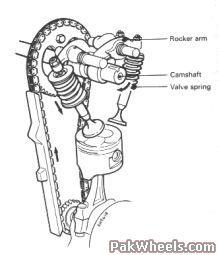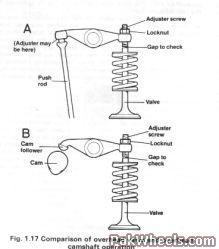@Salarzae
Very Good try at explaining it but for a normal person a bit confusing.
@Jack
In a OHV engine the cams are in the block not on the top of the engine with the valves and are operated by rod which is inturn pushed by the cams in the block and rotated by the crankshaft. This can be identified by the engine having a smaller head then the OHV. here is a pic to explain

Up to certain speeds there are no problems, but beyond that, the weight of the Valve train components are such that they are unable to respond quick enough to the Camlobe passes and begins to fall away. At this point, the valves start to "FLOAT" and damage can occur.
Another problem arises in the weight factor of all these moving parts which need to be very strong indeed to withstand the pressures they have to bear.
These limitations forced designers to look at other alternatives in Valve operations to improve engine performance.
As for the OHV it has the same setup as the SOHC where the cams and the valves are placed on the top of the block in the head and hence the bigger head. OHV is mostly associated with 2 valves/cylinder as the SOHC can also be 4 valves but turned by a single cam. This is inturn driven by a chain or a rubber belt connected to the crank. The folowing pics will give an example.

To overcome the weight problem, it became desirable to eliminate as many of the non-rotating parts as possible. These include the Cam follower, pushrod, rocker and the valve itself. In the case of the valve however, little can be done other than to reduce its weight by careful design and and the choice of strong, durable but lightweight materials.
In a typical SOHC engine, the camshaft has been moved up and housed at the centre of the cylinder Head between the valves. On some early designs, the camshaft was driven by bevel gears and a driveshaft, but in general, a relatively cheap and simple chain drive from the crankshaft was used.
The only moving (Non Rotating parts) left were the Rockers and Valves. Not perfect but an improvement on the older Pushrod method of valve operation.

Then we have the DOHC which is again similar setup to the OHV/SOHC but with two Cams driving different pair of valves.